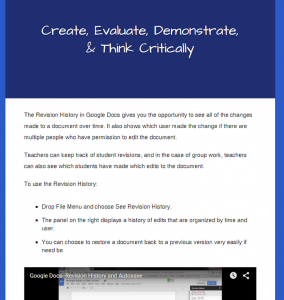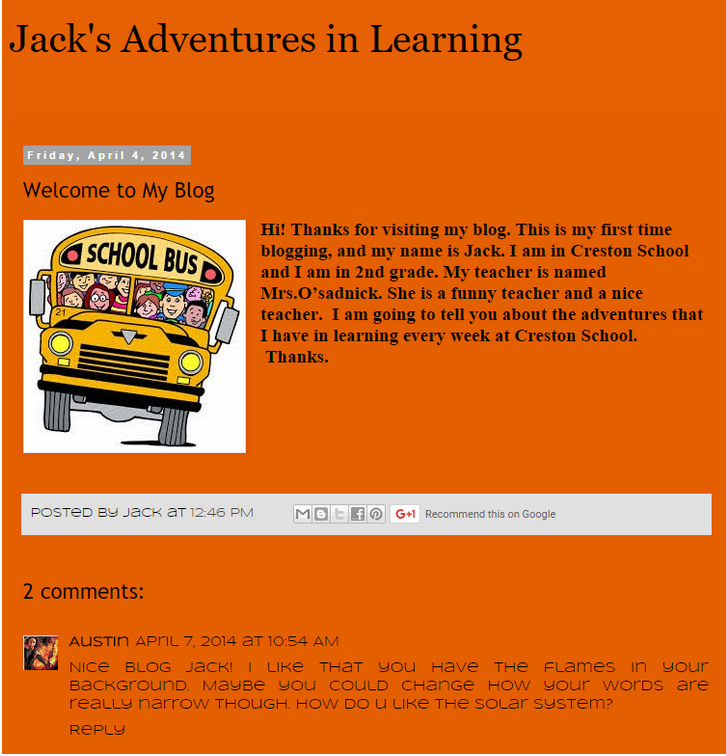This post first appeared on Daily Genius.
In his blog post on Kidblog.org entitled, Top 3 Reasons I Have My Students Blog, Steve Kowalski says,
"When it comes to writing, the more feedback a student receives, the more they want to write. Even a small number of comments creates positive reinforcement that will motivate students to write."
For fourteen years, I was the technology coordinator for a very small school district in the middle of a cornfield in Northern Illinois. From that small world, a wider audience didn’t seem plausible. I honestly didn’t believe that anything I could contribute would be valuable in a larger world. I assumed other people had already made my discoveries and shared them, and I feared sharing my ideas would do more to demonstrate my lack of expertise than augment my credibility.
Feedback Becomes Fuel
In the fall of 2015, I created a presentation for a state edtech conference using Tackk. After my face to face presentation, I realized that one of my participants, Michael Moylan, a fabulous teacher from Illinois, had tweeted about it and shared the link. I was so honored. Earlier in the conference I had attended one of his sessions, and I was so impressed with the incredible things he was doing in his classroom. It felt amazing that he valued the ideas that I shared.
On the two and a half hour trip home from the conference, the feedback began. It’s hard to explain the excitement that I experienced as strangers “favorited” or “retweeted” my work. I was floored by how empowered I felt as my eyes remained glued to my smartphone. I wasn’t sure why I was so excited, but I knew one thing for sure: I wanted more.
I began publishing more of my ideas using the Tackk format. I began to share them myself on Twitter and Google+. Then, two days after the conference, I got an email from the Tackk website. It was a picture of a gold trophy, and it said, “Your ‘Read, Write, and Speak All About It’ Tackk has reached a new milestone: 100 Views.” Gasp! I was overwhelmed. 100 views? There weren’t 100 people in my audience at my presentation. That meant that other people must have seen it on Twitter when Michael shared it.
Intrinsic & Extrinsic Motivation
 The irony of the story of these experiences is that the Tackk presentation I had created was about digital publishing. In it, I had explained the concept of students publishing to a wider, more authentic audience. As a technology teacher, my role was to create opportunities for students to publish online. I understood the reality that publishing creates an authentic audience. Over the years, my students had published blogs, projects, and an online newspaper. I remember rejoicing at my students’ reactions and conversations. I had smiled at the giggles about how that cute basketball player from the neighboring school might see that presentation they’d created. The quiet and shy student who was so proud of her 10 followers to her blog made my heart sing. When I overheard a boy talking about his grandma in Wisconsin who enjoyed the virtual experience of attending a class play via pictures and an article on our online newspaper, I knew these experiences were meaningful.
The irony of the story of these experiences is that the Tackk presentation I had created was about digital publishing. In it, I had explained the concept of students publishing to a wider, more authentic audience. As a technology teacher, my role was to create opportunities for students to publish online. I understood the reality that publishing creates an authentic audience. Over the years, my students had published blogs, projects, and an online newspaper. I remember rejoicing at my students’ reactions and conversations. I had smiled at the giggles about how that cute basketball player from the neighboring school might see that presentation they’d created. The quiet and shy student who was so proud of her 10 followers to her blog made my heart sing. When I overheard a boy talking about his grandma in Wisconsin who enjoyed the virtual experience of attending a class play via pictures and an article on our online newspaper, I knew these experiences were meaningful.
The term “authentic audience” had made sense to me in the past. I understood the idea to mean that it was a wider community of readers, beyond just the classroom, the teacher, and the parents. But once I experienced the feedback from that audience, it became so real. It became fuel for my motivation tank. I was intrinsically proud of myself, but at the same time, I was completely fueled by that vast, unknown audience. I couldn’t help but think: if I, as a grown adult, could find such power, such energy, such motivation by retweets, favorites, and kind words, what could that mean for students?
Student Praise
 Students love praise, and it often transcends into feelings of self-worth, intelligence, and joy. Joy creates optimism, which can be contagious in a classroom. Optimism, self-confidence, and success breed more success. In my classroom, when a struggling student had a moment of true success, I often saw a metamorphosis begin to occur. The feeling of success coupled with praise from others seemed to consistently be a strong motivator to continue the behavior that caused the praise and success.
Students love praise, and it often transcends into feelings of self-worth, intelligence, and joy. Joy creates optimism, which can be contagious in a classroom. Optimism, self-confidence, and success breed more success. In my classroom, when a struggling student had a moment of true success, I often saw a metamorphosis begin to occur. The feeling of success coupled with praise from others seemed to consistently be a strong motivator to continue the behavior that caused the praise and success.
In my experience with my own children, I’ve found that praise from a parent often becomes commonplace. Praise from a teacher can make more of an impact. Students crave praise from their teachers. I also found that my students coveted praise and acceptance from their own peer group and loved working with students from other grade levels. The day that the second graders in Stacy O’Sadnick’s class got to read the comments from their 6th grade blog buddies was epic for all of us. The level of excitement in the room was consuming as the students experienced the joy of discovering what the “big kids” thought about their posts.
Beyond their own circles, what would praise from another teacher in another state mean? What would praise from other kids across the country mean? A testimonial from Celia Coffa on the Comments4Kids blog, an incredible website that coordinates and encourages educators to comment on student blogs, perfectly depicts the power of feedback from the wider audience.
The Power comes from the two-way relationship between the writer and the readers. The affirmation, validation and encouragement received when one receives comments is a strong motivator….We all like feedback!! This particularly applies to children who are new to blogging, but also applies to those of us a little older.
As students receive authentic feedback from a wider audience about their writing, that feedback becomes the fuel for intrinsic motivation, and the result is praise that can potentially create opportunities for increased success, pride, self-confidence and joy in learning.
To learn more from Avra and other EdTechTeacher instructors, join us at our Summer Institutes!

